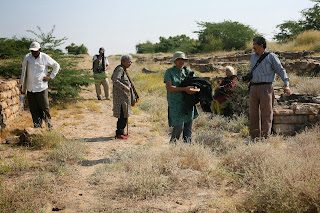We
left our eco camp at the Little Rann of Kutch in the morning of Friday November
15 and headed on to Dholavira, another major site of the Indus Valley
Civilization.

We
had a lively discussion about religion and politics along the way. Roxna’s
husband, Subrahmanian Swamy, is a leading Hindu nationalist / Hindutva
ideologue, and Roxna’s sympathies lie in that direction as well, although she
is herself a Parsi. They are both especially interested in the Rama Setu (Rama’s
Bridge) line of coral reefs and sandbanks stretching some 30 km from the
southern tip of India to Sri Lanka, which may or may not be a human-made
feature that may or may not be associated with the events of the Hindu Ramayana
epic, which tells of the God Rama building a bridge there so he could cross
over to Sri Lanka and rescue his kidnapped wife Sita.
A
NASA photograph from 1994 clearly showing the line of shoals attracted Hindu
interest, and Subrahmanian and Roxna have been involved in legal cases to stop
damage to this religiously significant feature by the planned construction of a
shipping canal across it.
The
NASA photograph from 1994 of the Rama Setu (from Wikipedia)
Dholavira
is located on an ancient island once surrounded by the seasonally flooded Great Rann of
Kutch, not far from the Pakistani border. At Dholavira we stayed in some
government tourist bungalows and met up again with Dr. Rawat, the Director of
the Gujarat State Department of Archaeology, who had excavated there in the 1990s.
That afternoon Dr. Rawat took us to the nearby site of Jhandiasar on the shore
line of the Great Rann of Kutch where there are fossilized trees from the
Jurassic period.

The
bungalows at Dholavira
The
fossil site of Jhandiasar
A fossilized tree
Dr.
Rawat speaking about the site with the well-preserved eastern walls of the
citadel in the background
Dr. Rawat by a remarkable column base
Dr. Rawat and his assistant in a room with two remarkable pillars
The remains at the top of the citadel
We
took our group photograph in the north gate into the citadel.
Throughout
the trip Prithi filmed the places we visited.

The
next day, Saturday November 16, Dr. Rawat gave us a lengthy tour of this large
and spectacular archaeological site with an upper citadel and a lower town and especially
impressive water reservoirs.
Dr. Rawat by a remarkable column base
Dr. Rawat and his assistant in a room with two remarkable pillars
The remains at the top of the citadel
Our
group photograph
The
group in the lower city
One
of the large reservoirs
Prithi
filming Dr. Rawat speaking about the reservoirs
In
the afternoon we toured the Dholavira site museum and then went to a lady in
the village who has handicraft textiles for sale; her son spent the time we
were there watching videos on his computer.

Shopping
for handicraft textiles











1 comment:
Dear Robert Schick,
Seen your post on Lothal & Dholavira. Nice to see the commentary on our visit.
Thanks.
Post a Comment